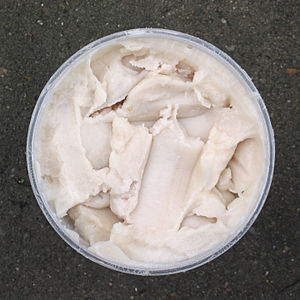
Back Ensundia AN دهن حيواني Arabic চর্বি Bengali/Bangla Sagí Catalan Živočišné tuky Czech Animalsk fedt Danish Tierfett German Grasa animal Spanish Gantz Basque Eläinrasva Finnish
 Wet-rendered lard, from pork fatback. | |
| Fat composition | |
|---|---|
| Saturated fats | |
| Total saturated | 38–43%: Palmitic acid: 25–28% Stearic acid: 12–14% Myristic acid: 1% |
| Unsaturated fats | |
| Total unsaturated | 56–62% |
| Monounsaturated | 47–50%: Oleic acid: 44–47% Palmitoleic acid: 3% |
| Polyunsaturated | Linoleic acid: 6–10%[1] |
| Properties | |
| Food energy per 100 g (3.5 oz) | 3,770 kJ (900 kcal) |
| Melting point | backfat: 30–40 °C (86–104 °F) leaf fat: 43–48 °C (109–118 °F) mixed fat: 36–45 °C (97–113 °F) |
| Smoke point | 121–218 °C (250–424 °F) |
| Specific gravity at 20 °C (68 °F) | 0.917–0.938 |
| Iodine value | 45–75 |
| Acid value | 3.4 |
| Saponification value | 190–205 |
| Unsaponifiable | 0.8% |
Animal fats and oils are lipids derived from animals: oils are liquid at room temperature, and fats are solid. Chemically, both fats and oils are composed of triglycerides. Although many animal parts and secretions may yield oil, in commercial practice, oil is extracted primarily from rendered tissue fats from livestock animals like pigs, chickens and cows. Dairy products yield animal fat and oil products such as butter.
Certain fats, such as goose fat, have a higher smoke point than other animal fats, but are still lower than many vegetable oils such as olive or avocado. [2]
Animal fats are commonly consumed as part of a western diet in their semi-solid form as either milk, butter, lard, schmaltz, and dripping or more commonly as filler in factory-produced meat, and fast-food products.[3]
- ^ National Research Council. (1976). Fat Content and Composition of Animal Products.; p. 203. Washington, DC: Printing and Publishing Office, National Academy of Science. ISBN 0-309-02440-4
- ^ The Goose Fat Information Service, Goosefat.co.uk, 2012-03-19, retrieved 2012-03-19
- ^ Meat Products with High Levels of Extenders and Fillers, Food and Agricultural Organization of the United States, archived from the original on 2019-02-07, retrieved 2012-03-16